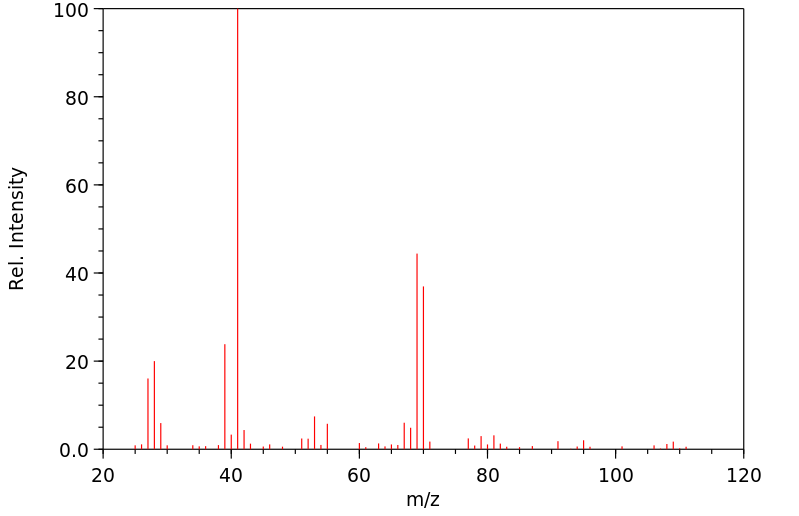反,反-2,6-壬二烯醛 | 17587-33-6
物质功能分类
中文名称
反,反-2,6-壬二烯醛
中文别名
反式2,6-壬二醛;反-2,6-壬二醛;反式-2,6-壬二醛
英文名称
(E,E)-2,6-nonadienal
英文别名
2,6-Nonadienal, (E,E)-;(2E,6E)-nona-2,6-dienal
CAS
17587-33-6
化学式
C9H14O
mdl
——
分子量
138.21
InChiKey
HZYHMHHBBBSGHB-DYWGDJMRSA-N
BEILSTEIN
——
EINECS
——
-
物化性质
-
计算性质
-
ADMET
-
安全信息
-
SDS
-
制备方法与用途
-
上下游信息
-
文献信息
-
表征谱图
-
同类化合物
-
相关功能分类
-
相关结构分类
物化性质
-
沸点:57 °C0.6 mm Hg(lit.)
-
密度:0.875 g/mL at 25 °C(lit.)
-
闪点:189 °F
-
溶解度:Practically insoluble in water, soluble in alcohol, Propylene glycol and oils.
-
LogP:2.60
-
物理描述:Liquid; tallowy aroma
-
折光率:1.439-1.445
-
保留指数:1153.1;1146;1146;1152;1162
-
稳定性/保质期:
遵照规定使用和储存,则不会分解。
计算性质
-
辛醇/水分配系数(LogP):2.2
-
重原子数:10
-
可旋转键数:5
-
环数:0.0
-
sp3杂化的碳原子比例:0.44
-
拓扑面积:17.1
-
氢给体数:0
-
氢受体数:1
安全信息
-
安全说明:S24/25
-
WGK Germany:3
-
危险性防范说明:P501,P210,P264,P280,P302+P352,P370+P378,P337+P313,P305+P351+P338,P362+P364,P332+P313,P403+P235
-
危险性描述:H315,H319,H227
-
储存条件:存放在0至6℃的阴凉干燥处。
SDS
模块 1. 化学品
1.1 产品标识符
: 反,反-2,6-壬二烯醛
产品名称
1.2 鉴别的其他方法
无数据资料
1.3 有关的确定了的物质或混合物的用途和建议不适合的用途
仅用于研发。不作为药品、家庭或其它用途。
模块 2. 危险性概述
2.1 GHS-分类
易燃液体 (类别 4)
2.2 GHS 标记要素,包括预防性的陈述
象形图 无
警示词 警告
危险申明
H227 可燃液体
警告申明
预防措施
P210 远离热源、火花、明火和热表面。- 禁止吸烟。
P280 戴防护手套/穿防护服/戴护目镜/戴面罩.
事故响应
P370 + P378 火灾时: 用干的砂子,干的化学品或耐醇性的泡沫来灭火。
安全储存
P403 + P235 保持低温,存放于通风良好处。
废弃处置
P501 将内容物/ 容器处理到得到批准的废物处理厂。
2.3 其它危害物 - 无
模块 3. 成分/组成信息
3.1 物 质
: C9H14O
分子式
: 138.21 g/mol
分子量
无
模块 4. 急救措施
4.1 必要的急救措施描述
一般的建议
请教医生。 向到现场的医生出示此安全技术说明书。
吸入
如果吸入,请将患者移到新鲜空气处。 如呼吸停止,进行人工呼吸。 请教医生。
皮肤接触
用肥皂和大量的水冲洗。 请教医生。
眼睛接触
用水冲洗眼睛作为预防措施。
食入
禁止催吐。 切勿给失去知觉者通过口喂任何东西。 用水漱口。 请教医生。
4.2 主要症状和影响,急性和迟发效应
据我们所知,此化学,物理和毒性性质尚未经完整的研究。
4.3 及时的医疗处理和所需的特殊处理的说明和指示
无数据资料
模块 5. 消防措施
5.1 灭火介质
灭火方法及灭火剂
用水雾,抗乙醇泡沫,干粉或二氧化碳灭火。
5.2 源于此物质或混合物的特别的危害
碳氧化物
5.3 给消防员的建议
如必要的话,戴自给式呼吸器去救火。
5.4 进一步信息
用水喷雾冷却未打开的容器。
模块 6. 泄露应急处理
6.1 作业人员防护措施、防护装备和应急处置程序
避免吸入蒸气、烟雾或气体。 移去所有火源。 谨防蒸气积累达到可爆炸的浓度。蒸气能在低洼处积聚。
6.2 环境保护措施
如能确保安全,可采取措施防止进一步的泄漏或溢出。 不要让产品进入下水道。
6.3 泄漏化学品的收容、清除方法及所使用的处置材料
围堵溢出,用防电真空清洁器或湿刷子将溢出物收集起来,并放置到容器中去,根据当地规定处理(见第13部
分)。 放入合适的封闭的容器中待处理。
6.4 参考其他部分
丢弃处理请参阅第13节。
模块 7. 操作处置与储存
7.1 安全操作的注意事项
避免吸入蒸气和烟雾。
切勿靠近火源。-严禁烟火。采取措施防止静电积聚。
7.2 安全储存的条件,包括任何不兼容性
贮存在阴凉处。 使容器保持密闭,储存在干燥通风处。
打开了的容器必须仔细重新封口并保持竖放位置以防止泄漏。
建议的贮存温度: 2 - 8 °C
充气操作和储存
7.3 特定用途
无数据资料
模块 8. 接触控制和个体防护
8.1 容许浓度
最高容许浓度
没有已知的国家规定的暴露极限。
8.2 暴露控制
适当的技术控制
根据良好的工业卫生和安全规范进行操作。 休息前和工作结束时洗手。
个体防护设备
眼/面保护
带有防护边罩的安全眼镜符合 EN166要求请使用经官方标准如NIOSH (美国) 或 EN 166(欧盟)
检测与批准的设备防护眼部。
皮肤保护
戴手套取 手套在使用前必须受检查。
请使用合适的方法脱除手套(不要接触手套外部表面),避免任何皮肤部位接触此产品.
使用后请将被污染过的手套根据相关法律法规和有效的实验室规章程序谨慎处理. 请清洗并吹干双手
所选择的保护手套必须符合EU的89/686/EEC规定和从它衍生出来的EN 376标准。
身体保护
防渗透的衣服, 防护设备的类型必须根据特定工作场所中的危险物的浓度和数量来选择。
呼吸系统防护
如危险性评测显示需要使用空气净化的防毒面具,请使用全面罩式多功能防毒面具(US)或ABEK型
(EN
14387)防毒面具筒作为工程控制的候补。如果防毒面具是保护的唯一方式,则使用全面罩式送风防
毒面具。 呼吸器使用经过测试并通过政府标准如NIOSH(US)或CEN(EU)的呼吸器和零件。
模块 9. 理化特性
9.1 基本的理化特性的信息
a) 外观与性状
形状: 液体
颜色: 无色
b) 气味
无数据资料
c) 气味阈值
无数据资料
d) pH值
无数据资料
e) 熔点/凝固点
无数据资料
f) 沸点、初沸点和沸程
57 °C 在 0.8 hPa - lit.
g) 闪点
87 °C - 闭杯
h) 蒸发速率
无数据资料
i) 易燃性(固体,气体)
无数据资料
j) 高的/低的燃烧性或爆炸性限度 无数据资料
k) 蒸气压
无数据资料
l) 蒸汽密度
无数据资料
m) 密度/相对密度
0.875 g/cm3 在 25 °C
n) 水溶性
无数据资料
o) n-辛醇/水分配系数
无数据资料
p) 自燃温度
无数据资料
q) 分解温度
无数据资料
r) 粘度
无数据资料
模块 10. 稳定性和反应活性
10.1 反应性
无数据资料
10.2 稳定性
无数据资料
10.3 危险反应
无数据资料
10.4 应避免的条件
热,火焰和火花。
10.5 不相容的物质
强氧化剂, 强酸, 碱
10.6 危险的分解产物
模块 11. 毒理学资料
11.1 毒理学影响的信息
急性毒性
无数据资料
皮肤刺激或腐蚀
无数据资料
眼睛刺激或腐蚀
无数据资料
呼吸道或皮肤过敏
无数据资料
生殖细胞致突变性
无数据资料
致癌性
IARC:
此产品中没有大于或等于 0。1%含量的组分被 IARC鉴别为可能的或肯定的人类致癌物。
生殖毒性
无数据资料
特异性靶器官系统毒性(一次接触)
无数据资料
特异性靶器官系统毒性(反复接触)
无数据资料
吸入危险
无数据资料
潜在的健康影响
吸入 吸入可能有害。 可能引起呼吸道刺激。
摄入 如服入是有害的。
皮肤 通过皮肤吸收可能有害。 可能引起皮肤刺激。
眼睛 可能引起眼睛刺激。
接触后的征兆和症状
据我们所知,此化学,物理和毒性性质尚未经完整的研究。
附加说明
化学物质毒性作用登记: RA5391720
模块 12. 生态学资料
12.1 生态毒性
无数据资料
12.2 持久性和降解性
无数据资料
12.3 潜在的生物累积性
无数据资料
12.4 土壤中的迁移性
无数据资料
12.5 PBT 和 vPvB的结果评价
无数据资料
12.6 其它不良影响
无数据资料
模块 13. 废弃处置
13.1 废物处理方法
产品
此易爆炸产品可以在备有燃烧后处理和洗刷作用的化学焚化炉中燃烧
将剩余的和不可回收的溶液交给有许可证的公司处理。
受污染的容器和包装
按未用产品处置。
模块 14. 运输信息
14.1 联合国危险货物编号
欧洲陆运危规: - 国际海运危规: - 国际空运危规: -
14.2 联合国运输名称
欧洲陆运危规: 非危险货物
国际海运危规: 非危险货物
国际空运危规: 非危险货物
14.3 运输危险类别
欧洲陆运危规: - 国际海运危规: - 国际空运危规: -
14.4 包裹组
欧洲陆运危规: - 国际海运危规: - 国际空运危规: -
14.5 环境危险
欧洲陆运危规: 否 国际海运危规 国际空运危规: 否
海洋污染物(是/否): 否
14.6 对使用者的特别提醒
无数据资料
模块 15 - 法规信息
N/A
模块16 - 其他信息
N/A
上下游信息
-
上游原料
中文名称 英文名称 CAS号 化学式 分子量 (2E,6E)-壬-2,6-二烯-1-醇 nona-2,6-dien-1-ol 5820-89-3 C9H16O 140.225
反应信息
-
作为反应物:参考文献:名称:八氢ac啶的不对称有机催化一锅策略摘要:简洁的序列:形成八氢ac啶的有效方法可提供高收率和高水平的立体定向控制,并且对不同的醛,苯胺和亲核试剂表现出极大的耐受性(请参阅示意图; TMS =三甲基甲硅烷基; EWG =吸电子基团) 。使用不同的亲核试剂可验证内过渡态,其中芳香环的π-π重叠在反应性和选择性中起重要作用。DOI:10.1002/anie.201006608
-
作为产物:描述:参考文献:名称:Hunsdiecker, Chemische Berichte, 1947, vol. 80, p. 141摘要:DOI:
文献信息
-
Expanding the Biocatalytic Toolbox with a New Type of ene/yne‐Reductase from <i>Cyclocybe aegerita</i>作者:Dominik Karrer、Martin Gand、Martin RühlDOI:10.1002/cctc.202002011日期:2021.5.7substrate scope including aliphatic and aromatic alkenes/alkynes from which aliphatic C8‐alkenones, C8‐alkenals and aromatic nitroalkenes were the preferred substrates. By comparing alkenes and alkynes, a ∼2‐fold lower conversion towards alkynes was observed. Furthermore, it could be shown that the alkyne reduction proceeds via a slow reduction of the alkyne to the alkene followed by a rapid reduction to这项研究引入了一种新的来自Cyclocybe aegerita的烯/炔还原酶,具有广泛的底物范围,包括脂肪族和芳香族烯烃/炔烃,其中脂肪族C8烯酮,C8烯烃和芳香族硝基烯是首选的底物。通过比较烯烃和炔烃,观察到向炔烃的转化率降低了约2倍。此外,可以表明,炔烃的还原是通过将炔烃缓慢还原为烯烃,然后快速还原为相应的烷烃来进行的。没有观察到烯烃的积累。此外,在α,β,γ,δ-的α,β位的双键区域选择性还原发生了不饱和的烯基。这以及不同的脂族和芳族炔烃首次生物催化还原为烷烃,突显了这种生物催化剂的新颖性。因此,通过对新的烯还原酶CaeEnR1的研究,揭示了一种有前途的底物范围,该范围可能描述了此类反应在化学领域内的广泛发生。
-
[EN] HYDROLYTICALLY LABILE PRO-FRAGRANCES CONTAINING α,β UNSATURATED ESTERS<br/>[FR] PRO-PARFUMS HYDROLYTIQUEMENT LABILES CONTENANT DES ESTERS α,β INSATURÉS申请人:HENKEL AG & CO KGAA公开号:WO2020058058A1公开(公告)日:2020-03-26The present invention pertains to pro-fragrances and relates to a pro-fragrance compound of the formula (I). Furthermore, the invention relates to compositions, a laundry product, a home care product, and an insect repellant, comprising the compound of formula (I). Also encompassed are a method for preparing the compound of formula (I) and uses of a compound of formula (I) for increasing the longlastingness of a fragrance, for increasing the stability and perception of a fragrance, and for improving the adhesion of a fragrance to textiles.
-
Cosmetic compositions申请人:Symrise AG公开号:EP2745878A1公开(公告)日:2014-06-25Suggested is a cosmetic compositions comprising (a) a crosspolymer obtained from copolymerisation of at least two different polyols and at least one dicarboxylic acid and (b) at least one fragrance.
-
Temporary Generation of a Cyclopropyl Oxocarbenium Ion Enables Highly Diastereoselective Donor-Acceptor Cyclopropane Cycloaddition作者:Juliette Sabbatani、Nuno MaulideDOI:10.1002/anie.201601340日期:2016.6.1tetrahydrofurans display three new chiral centers formed with highly diastereoselectivity. This method is stereocomplementary to most previously reported cycloadditions of malonate diesters, relies on the transient generation of cyclopropyl oxocarbenium ions, proceeds under mild conditions, and is based on the concept of temporary activation of an otherwise inert protecting group.
-
Organocatalytic Strategies for the Construction of Optically Active Imidazoles, Oxazoles, and Thiazoles作者:Łukasz Albrecht、Lars Krogager Ransborg、Anna Albrecht、Lennart Lykke、Karl Anker JørgensenDOI:10.1002/chem.201101817日期:2011.11.18demonstrates the first enantioselective synthesis of hydroxyalkyl‐ and aminoalkyl‐substituted imidazoles, oxazoles, and thiazoles. The approach developed utilizes a highly effective one‐pot reaction cascade that consists of either an organocatalytic epoxidation or aziridination of α,β‐unsaturated aldehydes coupled with a [3+2]‐annulation, in which amidines, ureas, or thioureas act as effective 1,3‐dinucleophilic
表征谱图
-
氢谱1HNMR
-
质谱MS
-
碳谱13CNMR
-
红外IR
-
拉曼Raman
-
峰位数据
-
峰位匹配
-
表征信息
同类化合物
(反式)-4-壬烯醛
(s)-2,3-二羟基丙酸甲酯
([1-(甲氧基甲基)-1H-1,2,4-三唑-5-基](苯基)甲酮)
(Z)-4-辛烯醛
(S)-氨基甲酸酯β-D-O-葡糖醛酸
(S)-3-(((2,2-二氟-1-羟基-7-(甲基磺酰基)-2,3-二氢-1H-茚满-4-基)氧基)-5-氟苄腈
(R)-氨基甲酸酯β-D-O-葡糖醛酸
(5,5-二甲基-2-(哌啶-2-基)环己烷-1,3-二酮)
(2,5-二氟苯基)-4-哌啶基-甲酮
龙胆苦苷
龙胆二糖甲乙酮氰醇(P)
龙胆二糖丙酮氰醇(P)
龙胆三糖
龙涎酮
齐罗硅酮
齐留通beta-D-葡糖苷酸
鼠李糖
黑芥子苷单钾盐
黑海棉酸钠盐
黑木金合欢素
黑曲霉三糖
黑介子苷
黄尿酸8-O-葡糖苷
麻西那霉素II
麦迪霉素
麦芽糖脎
麦芽糖基海藻糖
麦芽糖1-磷酸酯
麦芽糖
麦芽四糖醇
麦芽四糖
麦芽十糖
麦芽六糖
麦芽五糖水合物
麦芽五糖
麦芽五糖
麦芽五糖
麦芽三糖醇
麦芽三糖
麦芽三糖
麦芽三塘水合
麦芽七糖水合物
麦芽七糖
麦法朵
麦可酚酸-酰基-Β-D-葡糖苷酸
麦利查咪
麝香酮
鹤草酚
鸢尾酚酮 3-C-beta-D-吡喃葡萄糖苷
鸡矢藤苷







